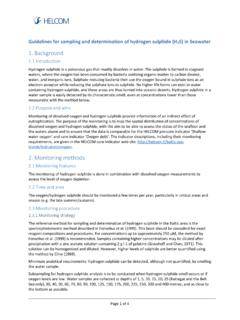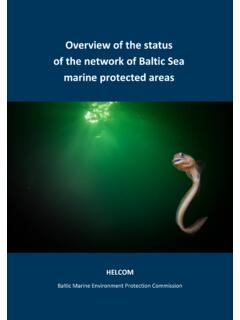Transcription of HELCOM Guide
1 HELCOM Guide to alien species and ballast water management in the baltic SeaBaltic Marine Environment Protection CommissionEditors: Marta Ruiz, Hermanni BackerFor bibliographic purposes this document should be cited as: HELCOM , 2014 HELCOM Guide to alien species and ballast water management in the baltic Sea Number of pages: 40 Informaton included in this publicaton or extracts thereof may be cited freely, on the condition that the complete reference for the publicaton is given as stated aboveCopyright: 2014 by the Baltc Marine Environment Protection Commission, HELCOML ayout: Juha R ty / photo: Zane JohnstonISBN 978-952-67205-6-2 (paperback) ISBN 978-952-67205-7-9 (PDF)Published by: HELCOM baltic Marine Environment Protection Commission Katajanokanlaituri 6 B FI-00160 Helsinki, Finland Summary.
2 52 Introduction ..63 alien species in the baltic Sea ..94 ballast water as vector of alien species ..135 ballast water discharges in the baltic Sea ..156 The ballast water management Convention implementation in the baltic Sea ..167 Introduction to the elements of the BWMC ..188 The regional baltic Sea area harmonised implementation of the IMO BWMC .. Where (Regulation B-4) and how (Regulation D-1) exchange ballast water in the baltic Sea area .. Exemptions to ballast water management (Regulation A-4) in the baltic Sea area .. Circumstances when ballast water management do not apply (Regulation A-3).
3 289 Port reception facilities ..29 Annex I More detailed information on the BWMC and its requirements ..30 Annex II Background studies on risk assessment in the baltic Sea area ..36 Annex III Contents of the A-3 exemption applications according to the joint HELCOM -OSPAR Guidance ..384 Image: Alberto Coz51 SummaryThe shallow enclosed form, low salinity and relatively lively maritime traffic makes the baltic Sea prone to entrance and settlement of non-native species1 present in ships ballast baltic Sea coastal countries cooperate within HELCOM (Hel-sinki Commission) for a harmonized implementation of the 2004 ballast water management Convention2 of the International Maritime Organi-sation (IMO) in the baltic Sea area.
4 This publication provides an overview of the regional baltic Sea measures related to shipping, developed by the Coastal countries and the European Union within the HELCOM Maritime Group (HEL-COM MARITIME). These actions include recommendations regarding ballast wa-ter exchange, target species and exemptions based on risk assessments (A-4). 1 non-indigenous species (NIS; synonyms: alien , exotic, non-native, allochthonous) are spe-cies, subspecies or lower taxa introduced outside of their natural range (past or present) and outside of their natural dispersal potential.
5 This includes any part, gamete or propagule of such species that might survive and subsequently reproduce. Their presence in the given region is due to intentional or unintentional introduction resulting from human activities. Natural shifts in distribution ranges ( due to climate change or dispersal by ocean currents) do not qualify a species as a NIS. However, secondary introductions of NIS from the area(s) of their first arrival could occur without human involvement due to spread by natural means. Invasive alien species (IAS) are a subset of established NIS which have spread, are spread-ing or have demonstrated their potential to spread elsewhere, and have an adverse effect on biological diversity, ecosystem functioning, socio-economic values and/or human health in in-vaded regions.
6 species of unknown origin which can not be ascribed as being native or alien are termed cryptogenic species . They also may demonstrate invasive characteristics and should be included in IAS assessments. (Olenin, S.; Alemany, F.; Cardoso, ; Gollasch, S.; Goulletquer, P.; Lehtiniemi, M.; McCollin, T.; Minchin, D.; Miossec, L.; Occhipinti Ambrogi A.; Ojaveer, H.; Jensen, ; Stankiewicz, M.; Wallentinus, I.; Aleksandrov, B. 2010. Marine Strategy Frame-work Directive Task Group 2 Report. Non-indigenous species . JRC Scientific and Technical Re-ports.)
7 Luxembourg: office for official publications of the European Communities, 44 pp.) 2 International Convention for the Control and management of Ships ballast water and Sedi-ments, the purposes of this Guide the baltic Sea area is delineated by the parallel 57 N (the Skaw) in the Skagerrak (see Figure 1). With a total area of about 370,000 km2, the baltic Sea area is one of the world s largest brackish water basins. 3 Figure 1 Map of the baltic Sea : Anu Hirvonen, Ilkka Lastum ki93 alien species in the baltic SeaAll alien speciesIn order to have an overview of species introductions over time a compre-hensive list of non-indigenous, cryptogenic and harmful native species intro-ductions in the baltic Sea has been compiled and updated by HELCOM since 20083.
8 Latest version of this list is accessible through a Fact Sheet Environmen-tal Sheet entitled Observed non-indigenous and cryptogenic species in the baltic Sea 4 and via the AquaNIS database5. The development of alien species introductions over time is presented in Figure 2, examples of species observed can be found in Table 1. Target alien species of special concernThe list of all introduced species in the region, as well as information on potential but not yet observed species was used as background information for further consideration, selection and agreement on the species of particular relevance in the context of the requirements of the ballast water management Conven-tion (BWMC).
9 This list of target species covers the potentially harmful animals, plants and algae present in the North Sea region, the Ponto-Caspian region, and the North American Great Lakes. It is based on information from the Black Sea Commission, the OSPAR Commission and the Great Lakes Available at: Available at: Available at: impactFirst recordSourceCercopagis pen-goi (Crustacea)Competes with herring for zooplank-ton prey1992 HELCOMa & NOBANISM arenzelleria spp. (Polychaeta, worm)Able to improve the oxygen condi-tions in the bottom sediment and affect nutrient fluxes from the sedi-ment/to the , Viitasalo-Frosen et al.
10 2009b; Norkko et al. 2012c Mnemiopsis leidyi (Cteno-phore, comb jelly)Spatially restricted to the southern baltic Sea, where amongst other prey ( , copepods, nauplii of the alien cirriped B. improvises and larvae of jellyfish Aurelia aurita) cannibalism on larval M. leidyi was et al. 2009d; Javidpour et al. 2009eNeogobius melanostomus (Fish, round goby)It primarily competes with the com-mercially important flounder Plat-ichthys flesus L. 1758; it also restricts habitat utilization and therefore food availability to P. flesus. The abun-dance of Gasterosteus aculeatus L. 1758 in the Gulf of Gdansk was also negatively correlated with his abun-dance, indicating a shift from pelagic to benthic forage fishes as its popula-tions increase in size 1990 Sapota & Sk ra, 2005f; Kornis et al.






